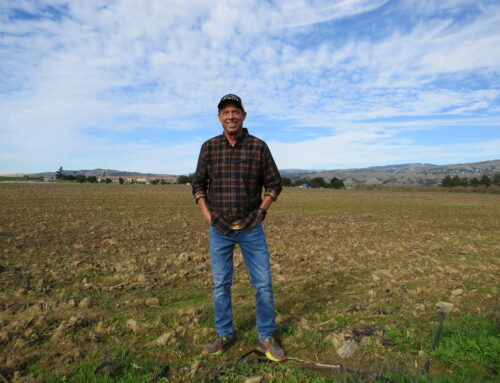Explorers camped along Llagas Creek
Published in the April 15-28, 2015 issue of Morgan Hill Life
By Staff Report

Descendents of the Anza party stand beside the newly installed historic plaque. Photo by Marty Cheek
Residents of Morgan Hill’s Woodland Estates Mobile Home Park have a piece of early California history in their backyards. The Spanish explorer Juan Bautista de Anza and his band of men camped along the Llagas Creek March 24, 1776. And 239 years later on March 28, the Daughters of the American Revolution hosted a ceremony to unveil a plaque to commemorate the history of the site.
“Putting the Juan Bautista de Anza commemoration together has been a wonderful experience,” said DAR State Historian Sally Holcombe. “I’ve had the privilege of working with the Morgan Hill Historical Society, city of Morgan Hill staff, the board of directors at the Woodlands Estates Mobile Home Park, Anza Expedition descendants and many DAR members.”
Colonel Anza led an expedition of 240 men, women and children that left New Mexico, Oct. 23, 1775. The group had two reasons for braving the treacherous journey to Alta California, Holcombe said. It established a supply route up the North American continent and it enabled the colonization of California by bringing settlers to what was then territory controlled by the Spanish Crown.
The families ended their journey at the Monterey Presideo March 22, 1776. Anza and a group of 12 soldiers continued journeying north over the Gavilan Range and into land that is now San Benito County. Two days after leaving Monterey, they camped along a creek near what is now Santa Teresa Boulevard.
From this camp, the group traveled north by horseback up the Peninsula, selecting sites for potential settlements. The Spanish later established missions at these sites that grew into the city of San Jose, Santa Clara and San Francisco. Many descendants of the Anza settlers still live in California, and several of them were at the ceremony. Speaking on their behalf was Superior Court Judge Paul Bernal.
“I want you to know that I brought four sleeping bags and we’ll be camping out here later tonight,” he said, joking about the camp site connection.
He especially thanked the DAR members who worked to erect the plaque which is set on a large granite stone. The 200th anniversary of the campsite was celebrated at the location March 24, 1976, with encampments by the expedition’s descendants and a plaque placement by the Morgan Hill Historical Society. The plaque disappeared over time, one reason why DAR members placed a large granite monument instead of a bronze plaque.
“To put up a plaque these days is not an easy task,” Bernal said. “I think they keep that story alive not only to honor the people of the past, but to honor the people of today. I think it’ll be a nice monument into the future.”




